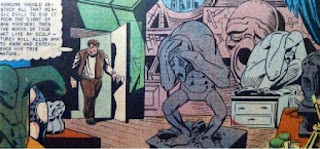Actually, I was a little surprised to see any mentions of Frye on HU at all. I had seen one of their contributors dismiss Frye as "old-fashioned"-- albeit on a forum, not on HU itself. Thus I thought it unlikely that any of HU's pundits would display an interest in the late Canadian myth-critic-- if only because his synoptic orientation, relating to seeing all literature as part of a vast pattern, would mean little in terms of HU's vaunted ideological aims.
Frye did get mentioned, albeit in passing, in Chris Gavaler's THE PHYSICS OF FICTION. After I read this essay, I googled Frye's name alongside that of HU, and saw a handful of essays that cited Frye, though none did so in a more substantive manner than Gavaler's piece. While I'm still surprised that the HU crew is even aware of Frye, the paucity of substantive writing suggests that he's merely a name to conjure with for these essayists, not someone that they trouble to research with the same intensity that they pursue the tortuous tautologies of Marx and Freud.
Gavaler's primary reference to Frye appears only because Frye is quoted by a critic with whom Gavaler disagrees:
Rothman resurrects Northrop Frye to fill the vacuum left by the collapsing genre system, but the Frye model’s four-part structure (novel, romance, anatomy, confession) is more likely to spread chaos (“novel” is a kind of novel?).
Now, I myself expressed some ambivalence about Rothman's citation, to wit:
As for Rothman, I see where he’s going with the invocation of Frye, but the four forms Rothman cites are not especially relevant to current literature. However, in the ANATOMY Frye also elucidated four *mythoi”– which he termed the romance, the comedy, the tragedy, and the irony– that are far more applicable.
For instance, some critics might say that WATCHMEN is good because it skewers the traditions of the adventure-oriented superhero narrative, which in Fryean terms would be “romance.” But that view is simplistic. WATCHMEN is a good work within its own mythos, that of the “irony,” whose nature is to satirize and downgrade all forms of human experience, not just types of disreputable pop-fiction. If adventure-oriented superheroes are good, they are either good or bad according to the romantic parameters they follow– but not because they don’t have enough satirical shit in them.
So I can give Gavaler a pass regarding his ambivalence on the "novel category" thing, since I myself don't think it's currently useful. However, later Gavaler once again assails Frye on his supposed lack of consistency:
Literary fiction is another problematic term. It traditionally denotes narrative realism, fiction that appears to take place here on Earth, but it’s also been used as shorthand for works of artistic worth. With the second half of the definition provisionally struck, we’re left with realism. Its solar center is mimesis, the mirror that works of literature are held against to test their ability to reflect our world. Northrop Frye declared mimesis one of the two defining poles of literature, though he had trouble naming its opposite. Frye located romance—a category that includes romance as well as all other popular genres (and so another conceptual strike against the Frye model)—in the idealized world, so Harlequin romances are part fantasy too (real guys just aren’t that gorgeous and wonderful).
In my own adaptation of Frye, I foreswore his term "romance" in favor of "adventure," in part because currently the word "romance" does have this modern connotation. However, I pointed out that Gavaler had falsified Frye's supposed "trouble" in naming the literary mode opposed to verisimilitude. I commented:
[The center’s] more like a binary star, and the people facing the other “sun” are the ones who like Borges more than Trollope.
I don’t think Frye had any difficulty naming the opposite of mimetic realism. In the ANATOMY he contrasts “versimilitude”– which is the reigning principle of the mimetic– with “myth.” And I quote:
“Our survey of fictional modes has also shown us that the mimetic tendency itself, the tendency to verisimilitude and accuracy of description, is one of two poles of literature. At the other pole is something that seems to be connected both with Aristotle’s word mythos and with the usual meaning of myth. That is, it is a tendency to tell a story which is in origin a story about characters who can do anything, and only gradually becomes attracted toward a tendency to tell a plausible or credible story.”
There have been defenders of “literary myth” in the humanities long before Frye, such as Andrew Lang. Their voices just weren’t as loud– hence, Gavaler’s description of modern criticism as being totally oriented upon verisimilitude/ mimeticism.Interested parties may check out Gavaler's response for themselves, but I found it superficial at best. I suggest that Gavaler dismissed Frye's image of a spectrum with two opposed modes because he's thoroughly in love with his "mimetic solar center" image, and Frye's continuum simply doesn't allow for such centrality.
Gavaler's confidence in the centrality of "the mimetic" extends to describing a experiment that supposedly demonstrates the pre-eminence of the mimetic mode. I won't spend any time describing it-- again, interested parties can check it out for themselves-- but I view it as a stunningly useless pseudo-experiment, one which doesn't even begin to answer my implied question, "If mimeticism is so on top of it all, how did Jose Luis Borges become a Literary Light?"
No big changes here, so no surprise that everything at HU stays the same.





















